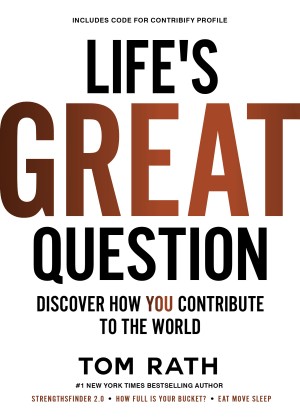The Author of ’StrengthsFinder 2.0’ Says Understanding Your Strengths Is Really Just the Start

You probably know Tom Rath as one of the key figures behind eternal best-seller StrengthsFinder 2.0 — so it might surprise you to learn that his latest work is about moving beyond your strengths.
Not that understanding your strengths isn’t important — it’s just not the full story of who you are at work and in life. Moreover, a purely strengths-based approach to careers, hiring, and team-building can often backfire. It can lead to teams and organizations full of people who all share the same talents, creating massive gaps in their capacities to really deliver lasting value to the world.
That’s why Life’s Great Question: Discover How You Contribute to the World, Rath’s latest book, broadens the scope to asking a critical big-picture question: What can you give to serve the greater good through your work?
Talking about strengths without talking about how to use those strengths to make real contributions to the world is “like having a conversation with a company where you’re not looking at the demand side of the equation, you’re only looking at the supply side,” Rath says.
In Life’s Great Question —and its attendant app, Contribify — Rath identifies 12 core contributions to the greater good that people can make through their work. He also helps people identify what their contributions are and how they can use their strengths to make the most of those contributions.
Below, we chat with Rath about the book, the app, and what he hopes HR pros take away from it all.
Recruiter.com: Let’s start with the basics: Can you tell us a little bit aboutLife’s Great Question?
Tom Rath: One of the things I’ve been working on throughout most of my career is: How do you help people to have more self-awareness and understanding about who they are? I’ve been working on this primarily for the sake of figuring out how people can use their careers to create more well-being for their colleagues, their customers, their communities, and the people they serve.
I’ve spent a lot of time on those topics, but in the last few years, I’ve stepped back and reflected on a lot of the questions I hear from people as they’re trying to figure out what to do with their careers. At some point, I realized these conversations were looking inward far too frequently. There’s no shortage of personality assessments, books about following your passion, or speeches on the topic. People are always probing their interests and so forth — but I really haven’t seen many programs or books or experts trying to tackle the question of, “What are the big things that the world needs out there in the broader marketplace?”
Essentially, it’s like having a conversation with a company where you’re not looking at the demand side of the equation, you’re only looking at the supply side. So I spent quite a bit of time over the last few years trying to go back and say, “Well, what is it that the job market values and needs us to serve in the workplace today?”
We spend most of our waking hours at work — a lot more hours than we do on any other focus or task. What I’ve found in a lot of the research I’ve been a part of over the years is that if we want to collectively improve people’s lives, these big networks that are our organizations are probably the best way to make that happen. I tried to work backward from, “How do you start with these organizations and what the world needs to help people figure out how their skills and their talents can fit into that big equation?”
RC:That brings us to Contribify. But which came first: Contribify or Life’s Great Question?

That’s something I’ve tried to do with most of the books I’ve worked on — going all the way back to my first one, How Full Is Your Bucket?, where we put these little drops for your bucket in the back of every book. That was an activity where, when you read the book, you go write a drop to someone to recognize something they did that made a difference for you. Those drops kind of caught on, and now they’re used pretty widely in public schools and the like.
So I always try to give people something to do. The Contribify website and application were built as I started thinking about, “How do you give people direction about how they can best contribute to the world?” I realized pretty quickly that, right now, what we have to give ourselves a guide and describe what we do are job descriptions on one hand and resumes on another. Both of those are relatively sterile and imperfect ways to summarize one’s contribution to the world, so we’re trying to put something together that hopefully makes that a little more personal.
RC: So what exactly is Contribify? What can a person expect to experience when they log in?
TR: The Contribify application starts with an inventory that asks each person some pretty basic questions about the big roles you play in life. In the end, what are you going to be known for? You’re not going to be known for being a vice president or having 100,000 followers on Twitter. You’re going to be known for being a parent, being a spouse — in my case being a researcher, being a writer — those kinds of fundamental things you do.
Contribify asks people about the big roles they play in life, and it asks them about the most influential life experiences that have shaped who they are and why they do what they do. What we’ve found through some of our work is that, if you ask people why they do what they do and they talk to one another about that when they are joining a new team or group, you get to know one another much faster. Boy, that helps out quite a bit!
Contribify also asks people about how they would describe their natural strengths in their own words, but the the main thing is the inventory takes people through a series of about 50 questions that help them prioritize how they want to contribute to a given team or effort. It includes questions like, “Here are four situations. Which would you most like to do to contribute to this team that you’re thinking about right now?”
The product of that inventory is kind of a one-page baseball card that’s hopefully a more human and personal version of a resume. It says, “Here’s who I am, and here’s how I want to contribute to a team.” And then it gives several pages of subsequent follow-up with specific tips and suggestions about how you can uniquely contribute based on how you prioritize some of those scenarios in the inventory.
For more expert hiring insights, check out the latest issue of Recruiter.com Magazine:
RC: What you’re outlining is a very different kind of approach to understanding ourselves and our roles at work. What kind of repercussions does this shift in perspective — from considering strengths and interests to considering contributions — have for how we hire and organize teams in the workplace?
TR: If there’s one thing I hope the Contribify application would be most helpful for, it is in the process of bringing teams together and helping everybody on a team have much clearer expectations about how they uniquely contribute relative to the other people that are part of that group.
Right now, if we pull a team together —whether it’s inside a big organization or a team in our community — we usually pull people together because they have the same interests. They might be friends of ours; they might be a lot like us. Then we all get together and say, “We’re excited about this! Let’s start off down this track!”
Everyone hits the ground running, and then usually it take three, six, nine months before people come back and realize: “You know what, we’re all kind of doing the same thing and overlapping and running down the same track.”
What I would encourage people to do instead is to step back from the outset and say, “As a team, here are the things we need to get done in order to make a positive contribution and be productive.” You have to make sure someone is putting the vision together and initiating things. You have to make sure someone is pulling the relationships together, energizing other members of the team, and keeping everybody communicating as you go along. You have to make sure someone is doing the operational and executional pieces.
As long as you have an open conversation about how people can complement one another and each have respective roles with as little overlap as possible, it should ensure that you have better expectations and move forward on much smoother parallel tracks.
And I also want to get people thinking when they form teams about how their contributions influence the people they’re trying to reach. A lot of the time, when you’re able to connect your contribution with the positive influence it has on another person, that’s usually a catalyst for even higher levels of productivity and well-being in the work you do.

